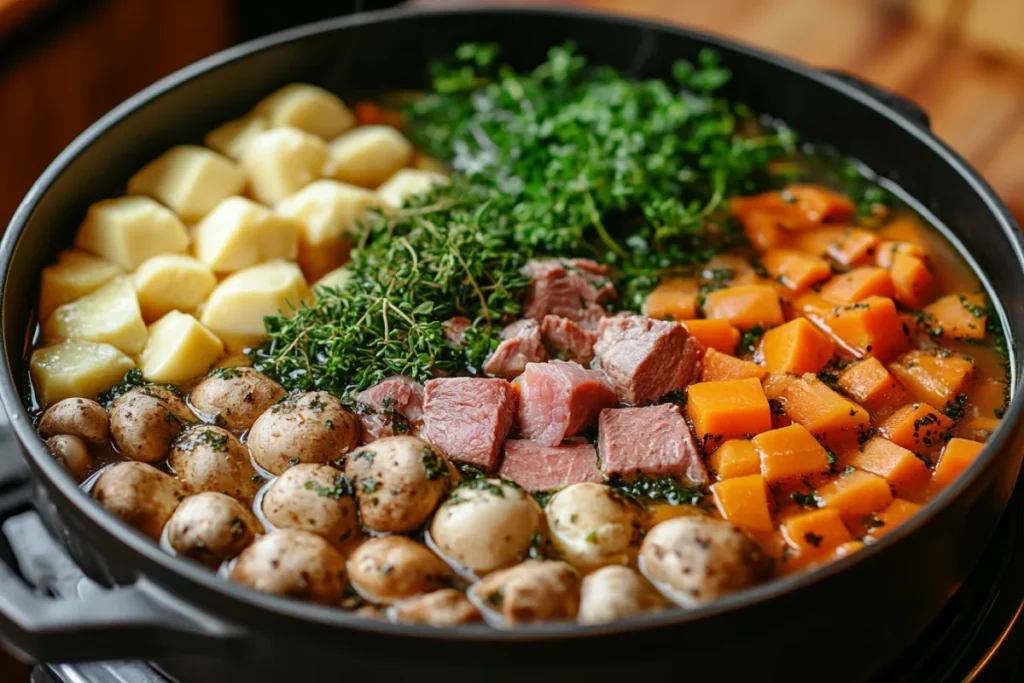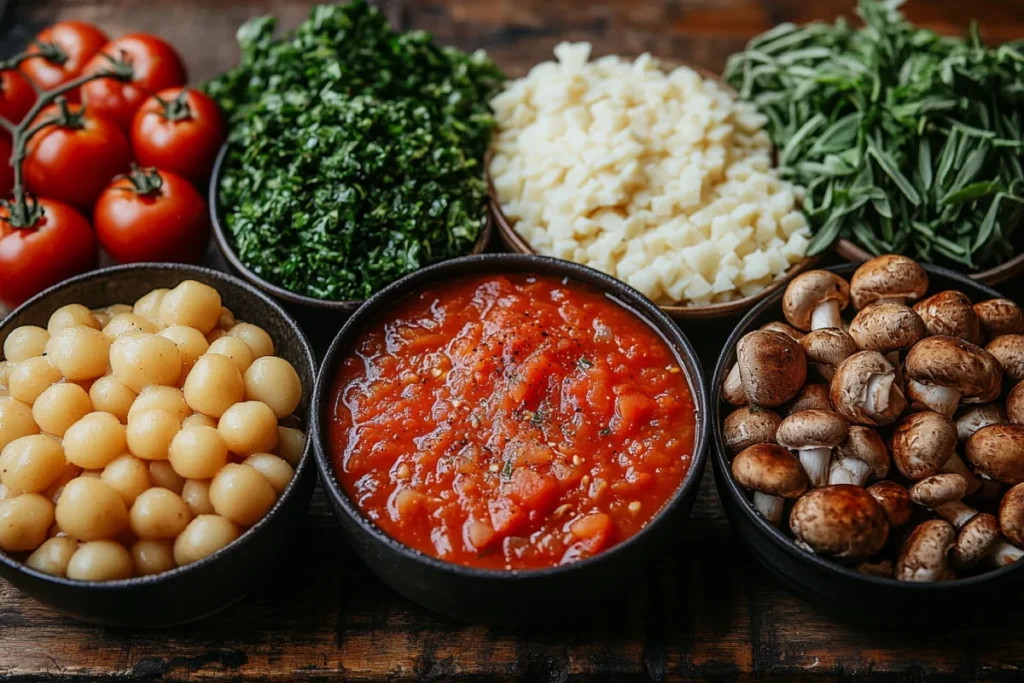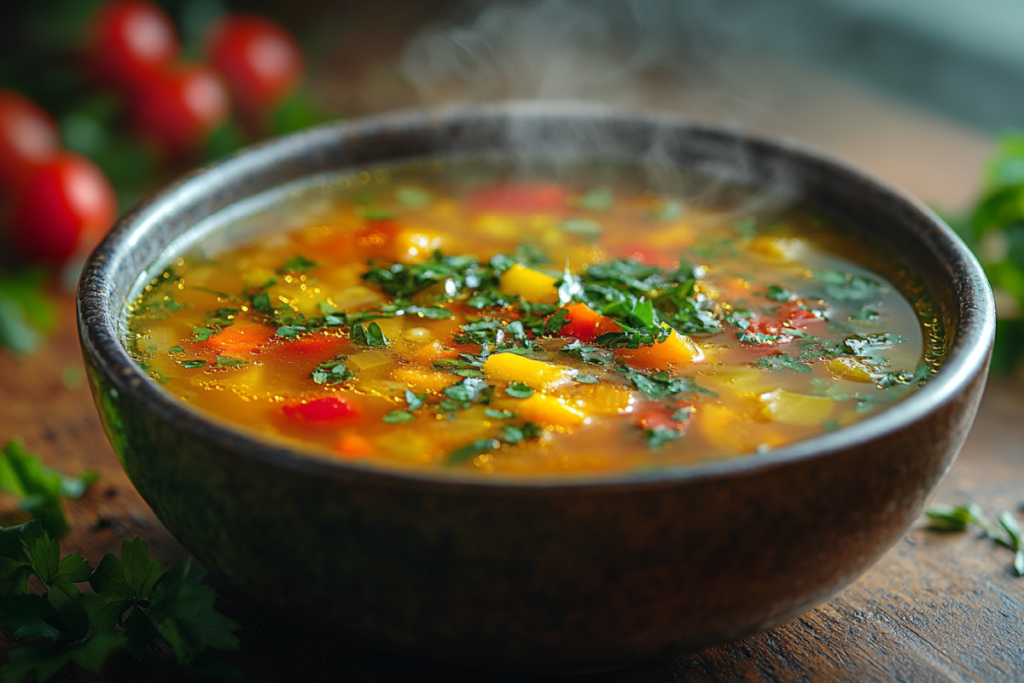There’s nothing more comforting than a steaming bowl of soup, but have you ever wondered why some soups taste extraordinary while others feel a little bland? The answer often lies in a secret ingredient in soup—a culinary magic touch that elevates the flavor, aroma, and texture of the dish. This article dives deep into the world of soup-making, uncovering the hidden elements and techniques that transform simple recipes into masterpieces.
When we talk about a “secret ingredient in soup,” it doesn’t always mean a single, exotic component. Instead, it can be a combination of small, thoughtful additions, timing, and technique that bring your soup to life. Let’s explore the science, art, and creativity behind finding your perfect secret ingredient in soup.
Understanding the Basics of Soup
Before diving into secret ingredients, it’s essential to understand the foundation of any good soup. Mastering the basics ensures that your secret ingredient in soup enhances rather than overwhelms the dish.
The Foundation: Stock or Broth
A soup’s backbone is its stock or broth, and the quality of this base sets the tone for the entire dish. Whether it’s chicken stock, beef broth, vegetable stock, or a seafood base, a well-made stock infuses richness and depth into your soup. Using a secret ingredient in soup—like a dash of umami-rich soy sauce or the addition of dried mushrooms—can elevate even a simple broth.
- Homemade Stock vs. Store-Bought: While store-bought broths are convenient, homemade stock allows you to control the flavor. Simmering bones, aromatics, and herbs for hours extracts nutrients and flavor compounds that you can’t replicate from a carton.
- Adding Complexity: Even store-bought broth can be elevated by simmering it with a bouquet garni (a bundle of fresh herbs) or by adding an umami-packed ingredient like dried mushrooms or miso paste.
To explore a specific example, consider how chicken tortilla soup achieves its creamy texture, showcasing the importance of thoughtful ingredient choices.
Balancing Flavors: Salt, Acidity, and Umami
Flavor balance is critical in soup-making. A secret ingredient often works because it enhances one of these key flavor profiles:
- Salt: A pinch of high-quality sea salt or kosher salt amplifies existing flavors. Always taste as you cook to avoid over-salting.
- Acidity: A splash of vinegar, a squeeze of lemon, or even a spoonful of yogurt can brighten the flavors of a soup, cutting through richness and enhancing other ingredients.
- Umami: The elusive “fifth taste,” umami is the savory, mouthwatering quality found in ingredients like soy sauce, parmesan cheese, and tomatoes. It’s often what makes a soup deeply satisfying.
If you’re interested in thickening and enhancing the body of your soups, learn about thickening chicken tortilla soup.

Exploring Common “Secret” Ingredients
Many cooks rely on tried-and-true secret ingredients that have been passed down through generations. These small additions often transform a recipe and define the true secret ingredient in soup for every chef.
Herbs and Spices
Fresh herbs and warming spices are often the understated heroes of soup. They infuse flavor without overpowering other elements. A touch of nutmeg, for example, might be the secret ingredient in soup that adds warmth and depth to a creamy base.
- Fresh Herbs: Parsley, cilantro, dill, or thyme can add brightness to a finished soup. A sprig of rosemary or bay leaves simmered with the soup layers subtle flavors into the dish.
- Spices: A pinch of nutmeg in creamy soups, a dash of smoked paprika for smokiness, or a hint of cumin in vegetable-based soups can transform the taste profile entirely.
- Finishing Touches: Garnishing with a drizzle of herb-infused oil or a sprinkling of fresh basil leaves adds visual and aromatic appeal.
Spices also play a key role in global soup recipes, like those found in dishes such as marry-me chicken soup, where bold flavors stand out.
Aromatic Vegetables: The “Holy Trinity” of Soup-Making
In many cuisines, soups begin with a base of aromatic vegetables. Known as a mirepoix in French cooking (onions, carrots, and celery), this trio forms the backbone of countless soup recipes.
- Caramelization: Slowly cooking aromatics until golden brown can add sweetness and complexity.
- Creative Variations: Adding leeks, shallots, or garlic to your base gives a new dimension to traditional recipes.
The Power of Umami in Soup
Umami is the flavor that turns a good soup into one that makes your taste buds dance. Often described as savory or meaty, umami flavors linger on the palate and create a sense of fullness. This makes umami-packed ingredients the ultimate secret ingredient in soup.
For a comforting and flavorful twist, check out the unique combinations in crockpot stuffed pepper soup, where umami-packed ingredients shine.
Natural Sources of Umami
Some of the best umami boosters are natural ingredients that you likely already have in your kitchen. These additions blend seamlessly into the soup, intensifying its flavor.
- Tomatoes: Whether fresh, roasted, or in the form of paste, tomatoes bring a rich, savory depth to soups. Sun-dried tomatoes are especially potent and can be rehydrated for maximum impact.
- Mushrooms: Varieties like shiitake, cremini, and porcini pack a powerful umami punch. Dried mushrooms are even more concentrated and can be rehydrated in the broth for an earthy boost.
- Parmesan Rind: Adding a leftover rind of parmesan cheese to your soup as it simmers infuses it with a subtle nutty flavor. It’s a secret many Italian cooks swear by.
Fermented and Aged Ingredients
Fermented and aged foods contain glutamates, the chemical compounds responsible for umami. These ingredients are particularly effective in creating depth and complexity in soups.
- Soy Sauce or Tamari: A splash of soy sauce adds salty, savory notes that enhance broth-based soups like miso or ramen. For gluten-free options, tamari is an excellent substitute.
- Fish Sauce: Popular in Southeast Asian cuisine, fish sauce has a strong aroma but melds beautifully into soups, providing an unmistakable umami kick.
- Miso Paste: A spoonful of miso dissolved into the soup at the end of cooking adds a creamy, savory flavor. It’s particularly effective in vegetable and seafood soups.
These umami-packed ingredients serve as the backbone for soups that leave a lasting impression.
Unexpected Ingredients That Transform Soup
While traditional flavor boosters work wonders, sometimes a surprising ingredient is what sets your soup apart. These “unexpected” additions are the creative secret weapons of professional chefs and home cooks alike.
Dairy Products for Creaminess
Dairy can add a luxurious texture and subtle flavor to many soups.
- Cream or Half-and-Half: A swirl of cream softens acidic flavors and adds a velvety mouthfeel to soups like tomato bisque or butternut squash.
- Yogurt or Sour Cream: Adding a dollop of tangy yogurt or sour cream to the soup just before serving creates a balanced richness.
- Cheese: Beyond parmesan, cheeses like cheddar, gruyere, or even blue cheese can add distinct and bold flavors to your soup.
Sweet Elements to Enhance Flavor Balance
A touch of sweetness can bring harmony to soups with spicy, sour, or savory profiles.
- Honey or Maple Syrup: These natural sweeteners are perfect for balancing the acidity of tomato-based or spicy soups.
- Fruit: Apples, pears, or even dried fruits like raisins or apricots can provide subtle sweetness in vegetable soups like squash or lentil.
- Coconut Milk: Common in Thai and Indian soups, coconut milk lends both creaminess and sweetness, enhancing the overall flavor profile.

Techniques That Enhance the “Secret Ingredient”
A secret ingredient can only work its magic when combined with the right cooking techniques. Timing, layering, and proper preparation are essential for bringing out the full potential of your chosen addition.
Timing: When to Add Your Special Ingredient
Knowing when to add the secret ingredient can make all the difference. The goal is to ensure that the flavors meld without losing the unique essence of the ingredient.
- Early Addition: Ingredients like bones, tough vegetables, or spices benefit from long cooking times. Adding them early allows their flavors to infuse deeply into the broth.
- Mid-Cooking: Starchy vegetables, fresh herbs, or umami boosters like soy sauce work best when added halfway through the cooking process to avoid over-extraction or bitterness.
- Final Touches: Delicate ingredients like cream, fresh herbs, or finishing oils (e.g., truffle oil) should be added at the very end of cooking to preserve their aroma and flavor.
Layering Flavors for Depth
Layering flavors involves building complexity step by step, ensuring every element contributes to the final dish.
- Sautéing Aromatics: Start with a hot pan and a bit of oil to sauté onions, garlic, and other aromatics. This step releases essential oils, creating a flavorful base.
- Deglazing the Pan: After sautéing, adding a splash of wine, broth, or vinegar to the pan helps lift flavorful caramelized bits and incorporates them into the soup.
- Tasting and Adjusting: As your soup simmers, taste frequently. Add small amounts of salt, acidity, or sweetness as needed to balance the flavors.
Enhancing Texture for Maximum Enjoyment
Texture is as vital as flavor in soup. Consider these tips to enhance the sensory experience:
- Pureeing: Use a blender or immersion blender to create smooth, creamy textures in soups like potato leek or pumpkin.
- Adding Crunch: Croutons, crispy fried shallots, or toasted nuts can provide a delightful contrast to smooth soups.
- Swirling Ingredients: Add cream, pesto, or yogurt in decorative swirls just before serving to create visual appeal and layers of flavor.
Presentation Matters
Even the tastiest soups can benefit from thoughtful presentation. Garnishes like chopped herbs, a drizzle of oil, or a sprinkle of spices signal care and elevate the dining experience.
The Role of the Secret Ingredient in Soup: Enhancing the Experience
The key to a memorable soup is not just the ingredients you use, but how they work together. A carefully chosen secret ingredient in soup can elevate a basic recipe into something extraordinary. Whether it’s a subtle addition of herbs or a surprising dash of a new spice, these secret ingredients work behind the scenes to enhance the depth, richness, and complexity of your soup. Understanding how these ingredients fit within the larger picture of soup-making can help you harness their full potential.
Layering Flavors with the Secret Ingredient in Soup
Flavor layering is essential when creating a soup that feels balanced and inviting. The process begins with a solid base, such as your stock or broth, which can be seasoned with your secret ingredient in soup at various stages of cooking. Adding a touch of miso paste to your vegetable broth early on can infuse your soup with umami, giving it that deep, savory flavor that’s often missing in basic vegetable-based soups.
But the secret ingredient in soup doesn’t always need to be added at the beginning. For instance, stirring in a splash of vinegar or a squeeze of lemon juice toward the end can elevate the flavors, giving them brightness without overwhelming the dish. A dash of soy sauce, added during the cooking process, can deepen the flavor without adding excessive salt, making it a perfect secret ingredient in soup.
Secret Ingredient in Soup: Umami’s Magic
One of the most powerful ways to enhance the flavor of your soup is by incorporating umami-rich ingredients. As the fifth basic taste, umami is the deep, savory flavor that adds a sense of fullness and satisfaction to a soup. For many cooks, the secret ingredient in soup is an umami booster like dried mushrooms, fish sauce, or even a parmesan rind. These ingredients can easily be incorporated into your soups and will help create an unforgettable eating experience.
Tomatoes are also an excellent source of natural umami. Whether fresh or sun-dried, they add a rich depth to tomato-based soups or stews. Roasted tomatoes bring out even more intense flavors, making them a fantastic secret ingredient in soups like a roasted tomato basil soup. By using tomatoes in various forms, such as paste, sauce, or sun-dried, you can layer umami throughout the dish for a complex flavor profile.
Unexpected Secret Ingredients to Explore
While umami is a go-to for many chefs when looking for a secret ingredient in soup, sometimes it’s the unexpected additions that truly make a dish shine. A sweet ingredient can balance out the acidity in a tomato-based soup or cut through the richness of a creamy bisque. A hint of honey, maple syrup, or a few slices of pear can introduce an unexpected sweetness that elevates the overall experience.
Another secret ingredient in soup worth exploring is the use of dairy products. A generous splash of cream or half-and-half can lend richness to a soup, making it velvety and smooth. Sour cream or yogurt can add a tangy twist, balancing out the heat in spicy soups like chili or curry. These dairy ingredients transform an otherwise simple soup into a comforting, luxurious meal.
Additionally, adding a spoonful of nut butter to a vegetable soup can give it a creamy texture while adding a nutty, savory undertone that perfectly complements root vegetables like squash and sweet potatoes. Peanut butter or almond butter are great choices to incorporate into soups that have a slightly sweet or spicy flavor base.
The Versatility of Herbs and Spices as Secret Ingredients
Herbs and spices are often the unsung heroes when it comes to soup-making. A dash of fresh thyme or rosemary can make the difference between a bland dish and a memorable one. A secret ingredient in soup could be as simple as adding a handful of fresh parsley or cilantro right before serving, infusing the dish with a burst of color and flavor. Warming spices like cumin, cinnamon, or nutmeg have the power to completely transform a dish, especially in soups with a rich, creamy texture.
The secret ingredient in soup can also come in the form of infused oils. Drizzling a small amount of truffle oil or basil-infused olive oil can elevate the sensory experience, adding not only flavor but an aromatic component that enhances the overall enjoyment of your soup. These finishing touches are ideal for heartier soups, like potato leek or roasted vegetable soup, where the flavor complexity is enhanced by the oil’s rich essence.
The Right Technique for Maximizing Your Secret Ingredient in Soup
Even the most amazing secret ingredient in soup will not reach its full potential if it’s added at the wrong time or without proper preparation. Techniques such as sautéing aromatics before adding your stock, or deglazing the pan with wine or vinegar after caramelizing vegetables, can intensify the flavors. These methods ensure that every part of your soup, including the secret ingredient, shines.
Timing is also critical when adding your secret ingredient. Some ingredients, like fresh herbs or delicate dairy products, should be added at the very end of the cooking process to preserve their flavor and texture. Other ingredients, such as garlic, spices, or dried mushrooms, benefit from being added early on, allowing their flavors to infuse into the broth and build a foundation of depth. Knowing when to add your secret ingredient can be the key to unlocking its full flavor potential.
Experimenting with Your Own Secret Ingredient in Soup
While there are tried-and-true secret ingredients that work for many chefs, one of the most rewarding aspects of soup-making is the opportunity to experiment. Your secret ingredient in soup could be a signature spice blend, a homemade stock, or a unique combination of umami-packed elements. The best way to discover your perfect secret ingredient is by starting with a simple soup recipe and adding new ingredients one at a time.
Taste as you go, and adjust seasonings as needed. Over time, you’ll begin to recognize which ingredients have the most profound effect on your soup’s flavor profile. Don’t be afraid to get creative—whether it’s a splash of miso paste, a sprinkle of smoked paprika, or even a surprising touch of dark chocolate, the possibilities for a secret ingredient in soup are endless.
By understanding how each component of your soup contributes to the overall flavor and texture, you can confidently incorporate your secret ingredient into every dish, creating a signature soup that will wow your friends and family.
FAQ
What common ingredient makes soups taste richer?
Adding umami-rich ingredients like soy sauce, mushrooms, or parmesan rind can make soups taste richer and more complex. Dairy products, such as cream or yogurt, also add depth and smoothness.
How do chefs get their soups so flavorful?
Chefs rely on high-quality stock, proper seasoning, and layering flavors. They also use techniques like deglazing and incorporating umami-packed ingredients to maximize flavor.
Can I create a secret ingredient at home?
Absolutely! Many home cooks create their own signature spice blends, infused oils, or even homemade stocks to use as their secret ingredient.
Are there vegetarian options for umami?
Yes! Ingredients like miso paste, nutritional yeast, roasted vegetables, and dried mushrooms are excellent vegetarian options for adding umami to soups.
What’s the best way to experiment with soup flavors?
Start with a basic recipe and add one new ingredient at a time. Keep tasting and adjusting as you go to learn how different flavors interact. Writing down your experiments can help refine your favorite combinations.
Table of Contents
Conclusion
Creating the perfect soup is a mix of art and science. While there’s no single secret ingredient in soup that works for every recipe, experimenting with umami-rich elements, unexpected additions, and thoughtful techniques can help you discover your signature touch.For more inspiration, don’t miss the opportunity to explore other soup-focused articles like what culture tortilla soup originates from.









